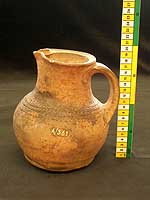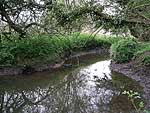Site 12 - Medieval Pottery
The wetlands within Tocil Wood were created by the clay extraction activities of medieval potters (and possibly also Roman tile manufacturers). The site with its readily accessible and useable clay, together with convenient supplies of water and fuel (charcoal) for kilns, was ideal for ceramic production until coal took over as the typical fuel for kilns. Within the current wetland environment several ponds had their origins as puddling pits used for preparing the clay and the watercourses that run through the wood are artificial leats, set to direct water between the pits. The medieval name of Tocil Wood was Potter’s Field Coppice, vividly evoking the historic use of this landscape.
|
|
|
 |
| Medieval Pitcher local ware |
The current name, Tocil Wood, probably derives from the teasels used in the carding and felting processes of cloth manufacture, a conclusion that can be reached by the existence of the fulling mill at Cryfield Grange.
|
|
||
| Teasel used for Carding and Felting Cloth |




